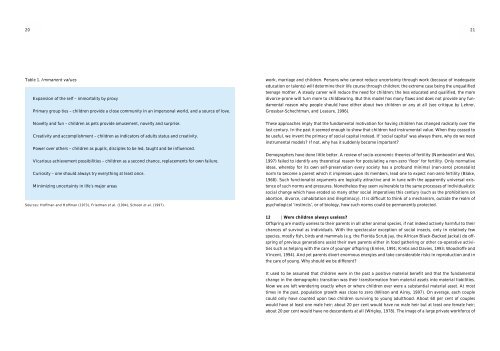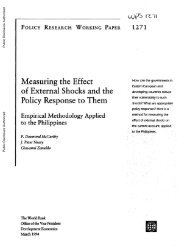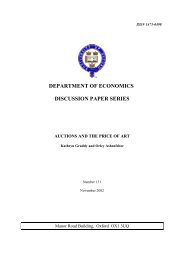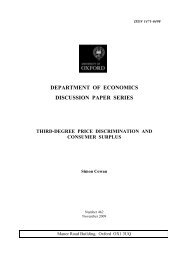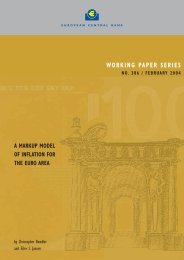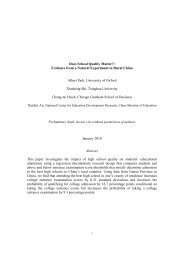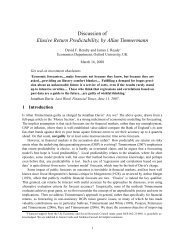Item.pdf - University of Oxford
Item.pdf - University of Oxford
Item.pdf - University of Oxford
You also want an ePaper? Increase the reach of your titles
YUMPU automatically turns print PDFs into web optimized ePapers that Google loves.
20<br />
Table 1. Immanent values<br />
Expansion <strong>of</strong> the self – immortality by proxy<br />
Primary group ties – children provide a close community in an impersonal world, and a source <strong>of</strong> love.<br />
Novelty and fun – children as pets provide amusement, novelty and surprise.<br />
Creativity and accomplishment – children as indicators <strong>of</strong> adults status and creativity.<br />
Power over others – children as pupils, disciples to be led, taught and be influenced.<br />
Vicarious achievement possibilities – children as a second chance, replacements for own failure.<br />
Curiosity – one should always try everything at least once.<br />
Minimizing uncertainty in life’s major areas<br />
Sources: H<strong>of</strong>fman and H<strong>of</strong>fman (1973), Friedman et al. (1994), Schoen et al. (1997).<br />
work, marriage and children. Persons who cannot reduce uncertainty through work (because <strong>of</strong> inadequate<br />
education or talents) will determine their life course through children; the extreme case being the unqualified<br />
teenage mother. A steady career will reduce the need for children; the less educated and qualified, the more<br />
divorce-prone will turn more to childbearing. But this model has many flaws and does not provide any fundamental<br />
reason why people should have either about two children or any at all (see critique by Lehrer,<br />
Grossbar-Schechtman, and Leasure, 1996).<br />
These approaches imply that the fundamental motivation for having children has changed radically over the<br />
last century. In the past it seemed enough to show that children had instrumental value. When they ceased to<br />
be useful, we invent the primacy <strong>of</strong> social capital instead. If ‘social capital’ was always there, why do we need<br />
instrumental models? If not, why has it suddenly become important?<br />
Demographers have done little better. A review <strong>of</strong> socio-economic theories <strong>of</strong> fertility (Namboodiri and Wei,<br />
1997) failed to identify any theoretical reason for postulating a non-zero ‘floor’ for fertility. Only normative<br />
ideas, whereby for its own self-preservation every society has a pr<strong>of</strong>ound minimal (non-zero) pronatalist<br />
norm to become a parent which it impresses upon its members, lead one to expect non-zero fertility (Blake,<br />
1968). Such functionalist arguments are logically attractive and in tune with the apparently universal existence<br />
<strong>of</strong> such norms and pressures. Nonetheless they seem vulnerable to the same processes <strong>of</strong> individualistic<br />
social change which have eroded so many other social imperatives this century (such as the prohibitions on<br />
abortion, divorce, cohabitation and illegitimacy). It is difficult to think <strong>of</strong> a mechanism, outside the realm <strong>of</strong><br />
psychological ‘instincts’, or <strong>of</strong> biology, how such norms could be permanently protected.<br />
12 | Were children always useless?<br />
Offspring are mostly useless to their parents in all other animal species, if not indeed actively harmful to their<br />
chances <strong>of</strong> survival as individuals. With the spectacular exception <strong>of</strong> social insects, only in relatively few<br />
species, mostly fish, birds and mammals (e.g. the Florida Scrub Jay, the African Black-Backed Jackal) do <strong>of</strong>fspring<br />
<strong>of</strong> previous generations assist their own parents either in food gathering or other co-operative activities<br />
such as helping with the care <strong>of</strong> younger <strong>of</strong>fspring (Emlen, 1991; Krebs and Davies, 1993; Woodr<strong>of</strong>fe and<br />
Vincent, 1994). And yet parents divert enormous energies and take considerable risks in reproduction and in<br />
the care <strong>of</strong> young. Why should we be different?<br />
It used to be assumed that children were in the past a positive material benefit and that the fundamental<br />
change in the demographic transition was their transformation from material assets into material liabilities.<br />
Now we are left wondering exactly when or where children ever were a substantial material asset. At most<br />
times in the past, population growth was close to zero (Wilson and Airey, 1997). On average, each couple<br />
could only have counted upon two children surviving to young adulthood. About 60 per cent <strong>of</strong> couples<br />
would have at least one male heir; about 20 per cent would have no male heir but at least one female heir;<br />
about 20 per cent would have no descendants at all (Wrigley, 1978). The image <strong>of</strong> a large private workforce <strong>of</strong><br />
21


